
Zusammenfassung:
Northern Italy offers some of the best routes for road cycling, with breathtaking scenery, scenic roads and rich cultural history along the way. Here are five of the best routes for road cycling in Northern Italy:
Stelvio Pass (Stelvio Pass): Located between Lombardy and Trentino-Alto Adige, the Stelvio Pass is one of the most famous and spectacular Alpine passes in Europe. At 2,758 meters above sea level, it offers an epic challenge for cyclists, with hairpin bends winding through breathtaking Alpine landscapes.
South Tyrolean Wine Routes: The South Tyrol region is famous for its picturesque vineyards and charming medieval villages. Wine routes pass through these areas, offering cyclists the chance to explore hilly landscapes, vineyards and historic cities such as Bolzano and Merano.
Tour of Lake Garda: Lake Garda, the largest lake in Italy, offers a panoramic route of approximately 160 kilometers that completely surrounds the lake. The route passes through picturesque towns, vineyards, olive groves and offers stunning panoramic views of the lake and surrounding mountains.
Colle del Nivolet: Located in the Gran Paradiso National Park, Colle del Nivolet is a wild and spectacular Alpine pass with a road that winds through pristine mountain landscapes. The climb offers a demanding but rewarding challenge for cyclists, with breathtaking views along the way.
Mortirolo Pass: Considered one of the hardest climbs in Europe, the Mortirolo Pass is an Alpine pass located in Lombardy, in the province of Sondrio. The climb is characterized by challenging slopes and tight hairpin bends, but offers spectacular views of the Orobie Alps and the surrounding valleys.
Cycling holidays in northern Italy
Cycling holidays in Northern Italy offer an unforgettable experience, with breathtaking scenery, historic towns and culinary delights along the way. Here are some suggestions for organizing your cycling holiday in Northern Italy:
Choose the route and duration: Decide the route you wish to follow and the duration of your cycling holiday. You can opt for a tour along one of the famous Alpine roads such as the Stelvio Pass or the Mortirolo Pass, or explore the coastal roads along Lake Garda or Lake Como. Be sure to plan an itinerary that suits your experience level and fitness level.
Prepare your equipment: Make sure you have a bike suited to the type of terrain you'll be tackling and check that it's in good condition. Bring the necessary equipment with you, such as helmet, lights, bicycle repair tools and water bottle. You might also consider the option of renting a bike on site if you don't have the option to bring one with you.
Choose accommodation: Plan where to sleep along the route. You could opt for accommodation in hotels, bed & breakfasts, farmhouses or campsites depending on your preferences and budget. Be sure to book in advance, especially during the high tourist season.
Explore attractions along the way: Along your itinerary you will have the opportunity to visit historic cities, medieval villages, castles, vineyards and more. Take time to explore attractions along the route and immerse yourself in the culture and history of the region.
Savor local cuisine: Take advantage of Northern Italy's rich culinary tradition by sampling regional dishes and local delicacies along the way. Stop at trattorias, restaurants and local markets to savor specialties such as fresh pasta, cheeses, cured meats, ice cream and local wines.
Respect the environment and road rules: During your cycling trip, remember to respect the surrounding environment and follow road rules. Keep the streets clean, respect pedestrians and other cyclists and always wear a helmet for your safety.
With good planning and a little adventure, cycling holidays in Northern Italy can be an unforgettable experience. Enjoy the journey and the magnificent landscapes this region has to offer!
Why is Italy the perfect place for cycling enthusiasts?
Italy is considered the perfect place for cycling enthusiasts for several reasons:
Breathtaking landscapes: Italy offers a variety of spectacular landscapes, ranging from the mountains of the Alps and the Apennines to Mediterranean coasts, picturesque lakes and hilly countryside. These breathtaking sceneries provide a perfect backdrop for unforgettable cycling excursions.
Cycling culture: Italy has a long and rich cycling tradition, with a culture that celebrates cycling as both a competitive sport and a recreational pastime. There are numerous cycling events, races and rallies taking place across the country, fueling the passion for cycling.
Scenic and Winding Roads: Italy's roads offer a variety of scenic and winding routes that are a real treat for cyclists. From famous Alpine passes such as the Stelvio and Gavia to the coastal roads of the Ligurian Riviera and the Amalfi Coast, there is a route suitable for all skill levels.
History and culture: Italy is rich in history, culture and artistic heritage, and many of its cities and regions can be explored by bicycle. Cyclists can visit ancient archaeological sites, medieval cities, rural villages and cities of art along the route, thus enriching their travel experience.
Cuisine and gastronomy: Italian cuisine is famous throughout the world and is another reason why Italy is the perfect place for cycling enthusiasts. During cycling excursions, cyclists can enjoy a variety of regional dishes, cheeses, cured meats, wines and other local products that make every meal a memorable culinary experience.
Cycling infrastructure: In recent years, Italy has invested significantly in cycling infrastructure, creating cycle paths, cycle tourism routes and cycle paths that connect cities, villages and tourist attractions. This infrastructure makes cycling safer and more accessible and offers cyclists the chance to explore the country in a sustainable way.
In summary, Italy offers a unique combination of spectacular landscapes, cycling culture, history, gastronomy and infrastructure that make it the perfect location for cycling enthusiasts from around the world.
Where to go cycling in Italy?
In Italy, there are many fantastic places to go cycling, for both amateur and professional cyclists. Here are some of the best places to go cycling in Italy:
The Roads of the Alps and the Apennines: The Alps and the Apennines offer some of the most iconic and challenging routes for cycling in Italy. From legendary Alpine passes such as the Stelvio, Gavia and Passo del Mortirolo, to the hillier routes of the Apennines, there is something for all levels of ability and ambition.
The Coasts and Islands: The Italian coasts, such as the Amalfi Coast, the Ligurian Riviera, the Costa Smeralda in Sardinia and the Etruscan Coast in Tuscany, offer spectacular scenery and panoramic roads ideal for cycling excursions. Italian islands, such as Sicily and Sardinia, also offer varied terrain and breathtaking views to explore by bike.
Cycle routes and cycle paths: Numerous cycle paths and cycle paths have been developed throughout Italy that connect cities, villages and tourist attractions. Among the most famous are the Ciclovia del Sole which crosses the peninsula from North to South, the Ciclovia dei Parchi in Emilia-Romagna, the Ciclovia Adriatica along the Adriatic coast and the cycle path along the Po river.
The Wine Regions: The Italian wine regions, such as Piedmont, Tuscany, Veneto and Sicily, offer a unique experience for lovers of cycling and good wine. Cycling through the vineyards, visiting the cellars and tasting local wines along the way is an unforgettable experience.
Cities of Art and Medieval Villages: Many Italian cities of art and medieval villages are easily explored by bicycle, offering a combination of historical, cultural and landscape beauties. Florence, Siena, Verona, Lucca, Mantua and many other places offer cycle itineraries that allow you to completely immerse yourself in their unique atmosphere.
Nature Reserves and National Parks: Nature reserves and national parks in Italy offer a variety of terrains and habitats ideal for cycling. Parks such as the Cinque Terre National Park, the Gran Paradiso National Park, the Gargano National Park and the Cilento National Park offer paths and cycle routes immersed in nature.
Regardless of the location you choose, make sure you are prepared with the necessary equipment and information to ensure a safe and enjoyable experience. Have a nice cycling trip in Italy!
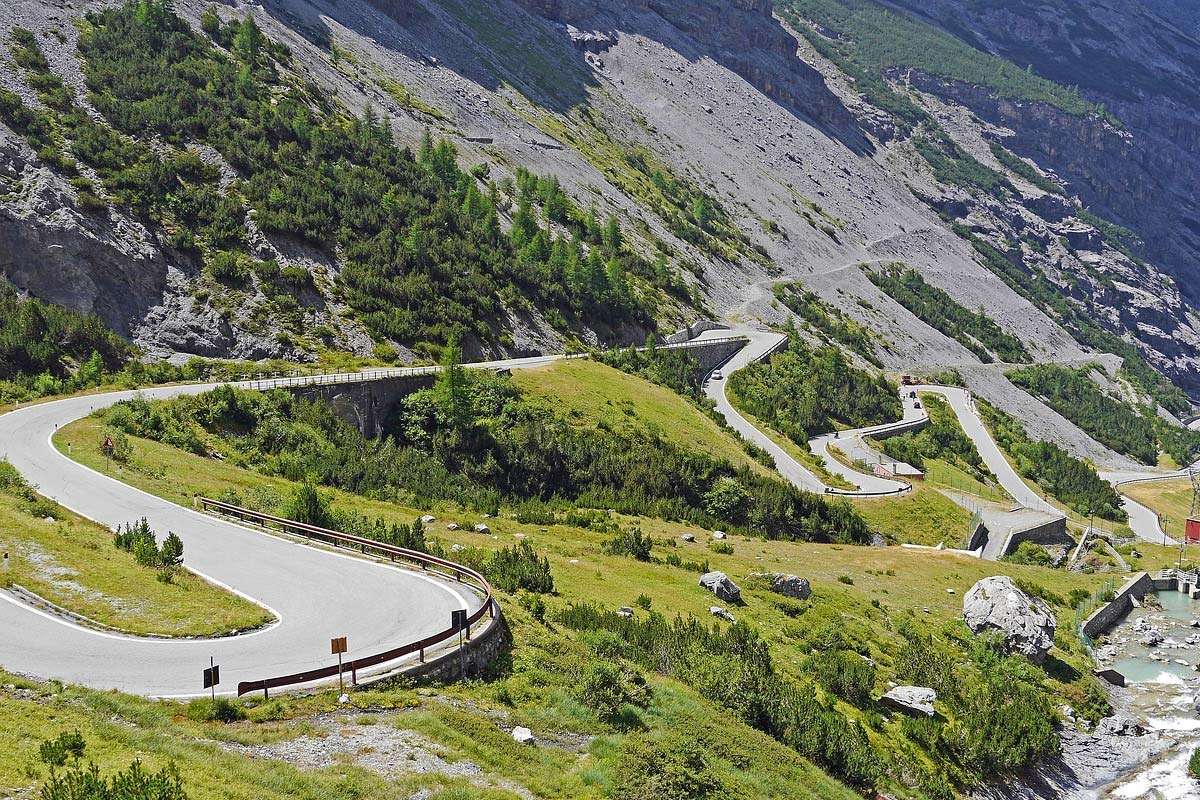
1. Stelvio Pass, Lombardy/Trentino-Alto Adige
Where is the Stelvio Pass?
The Stelvio Pass is one of the most famous and spectacular Alpine passes in Europe. It is located in the Italian Rhaetian Alps, on the border between the regions of Lombardy and Trentino-Alto Adige. Specifically, the Stelvio Pass is located in the province of Sondrio in Lombardy, not far from the border with the province of Bolzano in Trentino-Alto Adige.
What altitude is the Stelvio Pass?
The Stelvio Pass is generally open to vehicles during the summer months, usually from May or June to October, depending on weather conditions and snowfall. However, the precise opening and closing dates may vary from year to year depending on road conditions and weather forecasts.
Before planning a trip through the Stelvio Pass, it is always advisable to check the current road conditions and official opening dates. This can be done by consulting the local authorities' website or by contacting the local tourism office directly. Furthermore, it is important to keep in mind that the pass may be closed temporarily in case of bad weather or for maintenance work.
When is the Stelvio Pass open?
The Stelvio Pass is famous for its panoramic road, which reaches a maximum height of 2,758 meters above sea level, making it one of the highest passes in Europe reachable by car. The road that crosses the pass features 48 hairpin bends that wind through spectacular mountain landscapes and offer breathtaking views of the surrounding valleys.
Length and difference in altitude of the Stelvio Pass
The Stelvio Pass is one of the highest and most iconic Alpine passes in Europe. Here are some details on the length and height difference of the Stelvio Pass:
Length: The road that crosses the Stelvio Pass is approximately 24 kilometers (15 miles) long from Prato allo Stelvio, a municipality in the province of Sondrio, to Bormio, a municipality in the province of Sondrio. This length may vary slightly depending on your exact starting point.
Elevation Gain: The Stelvio Pass's elevation gain, or the difference in height between the lowest point and the highest point along the road, is approximately 1,871 meters (6,138 feet). The road reaches a maximum altitude of 2,758 meters (9,049 feet) above sea level, making it one of the highest passes in Europe.
These numbers indicate the significant challenge that the Stelvio Pass represents for cyclists, motorists and motorcyclists who face the climb through its 48 hairpin bends and the breathtaking landscapes of the Rhaetian Alps.
Where to sleep
The Stelvio Pass is located in the Italian Rhaetian Alps, in the province of Sondrio in Lombardy, not far from the province of Bolzano in Trentino-Alto Adige. However, there are no hotel or overnight accommodation facilities directly on the pass itself, as it is primarily a mountain road.
To find accommodation near the Stelvio Pass, you can consider nearby cities and municipalities, such as Bormio and Prato allo Stelvio. These locations offer a variety of lodging options, including hotels, bed & breakfasts, cottages and campsites.
Regarding the distance from Lake Idro, there is some distance between the two places:
The Stelvio Pass is located in the Italian Rhaetian Alps, in the province of Sondrio in Lombardy, not far from the border with the province of Bolzano in Trentino-Alto Adige.
Lake Idro, on the other hand, is located further south, in the Lombardy region, between Lake Garda and Lake Iseo.
The distance between the Stelvio Pass and Lake Idro is approximately 150-200 kilometres, depending on the route chosen and the precise starting and finishing points. This means that it would take some travel time to get from one place to another, as you pass through different regions and mountainous terrain.
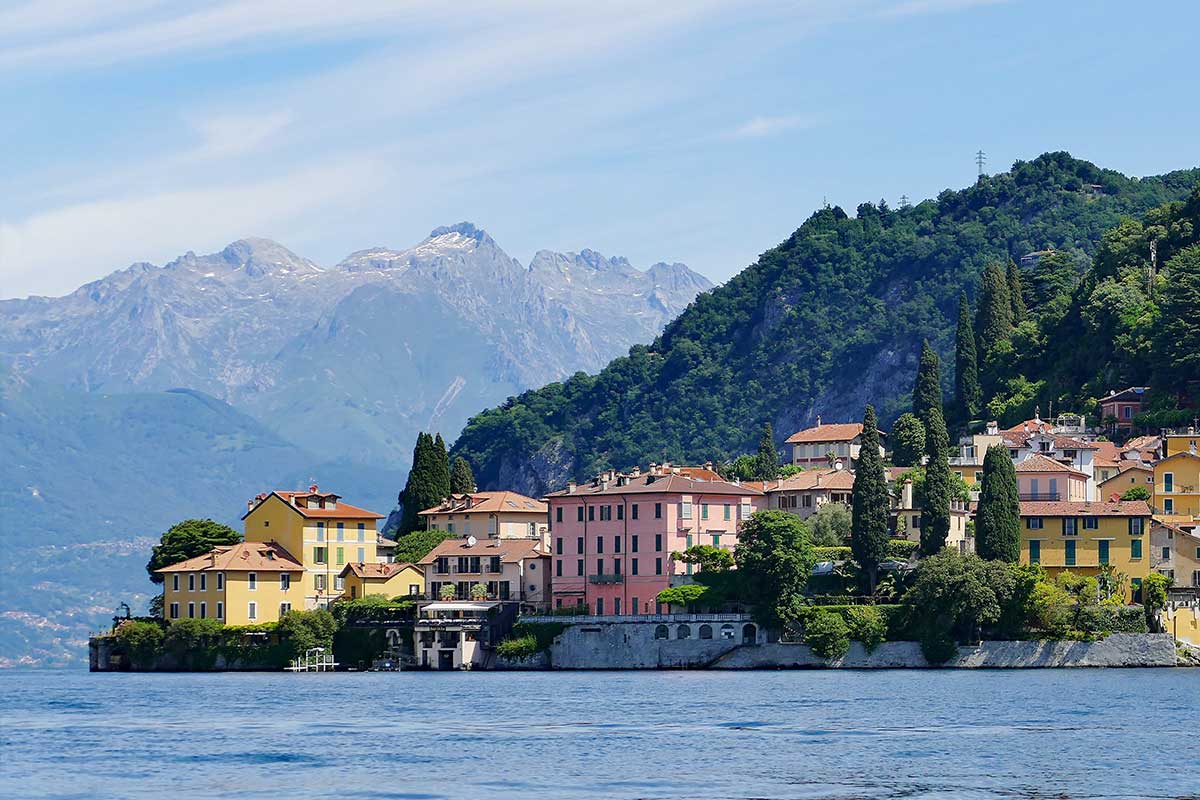
2. Lake Como Circuit, Lombardy
The Lake Como Circuit is a panoramic itinerary that entirely surrounds Lake Como, located in the Italian region of Lombardy. This route offers breathtaking views of the lake and surrounding mountains, passing through picturesque towns, historic villages and luxury villas along the way. Here is a general description of the Lake Como Circuit
Where is the Lake Como Bicycle Circuit?
Route: The Lake Como Circuit follows the main road along the shores of the lake, typically starting and finishing in the city of Como, located on the south-west side of the lake.
Length and difference in altitude of the Lake Como Circuit
The complete route is approximately 160 kilometers (about 100 miles) long, but can be divided into different stages or sections depending on cyclists' preferences.
Historic villas and picturesque towns along the way
Il Circuito del Lago di Como è ricco di ville storiche, paesi pittoreschi e villaggi affascinanti lungo il suo percorso. Ecco alcuni dei più suggestivi lungo il lago:
Como: La città di Como, situata sul lato sud-ovest del lago, è il punto di partenza e arrivo del circuito. Qui è possibile visitare la famosa Villa Olmo, una sontuosa residenza neoclassica circondata da un parco secolare sul lungolago.
Cernobbio: Situato sulla sponda occidentale del lago, Cernobbio è famoso per la sontuosa Villa d'Este, una residenza rinascimentale circondata da lussureggianti giardini all'italiana. La città è anche caratterizzata da graziosi vicoli e piazze, con vista sul lago e sulle montagne circostanti
Bellagio: Spesso chiamata la "Perla del Lago di Como", Bellagio è una delle destinazioni più rinomate lungo il percorso. Qui è possibile visitare la storica Villa Melzi, con i suoi meravigliosi giardini paesaggistici affacciati sul lago.
Varenna: Varenna è un affascinante borgo sulla sponda orientale del lago, caratterizzato da strette viuzze, case colorate e una pittoresca passeggiata sul lungolago. La città è dominata dalla storica Villa Monastero, con i suoi splendidi giardini botanici.
Menaggio: Situato sulla sponda occidentale del lago, Menaggio è un incantevole villaggio con una vivace passeggiata sul lungolago e una piazza centrale animata. Qui è possibile ammirare la suggestiva Chiesa di Santo Stefano e godere di splendide viste panoramiche sul lago e sulle montagne circostanti.
Lenno: Lenno è famosa per la spettacolare Villa del Balbianello, una residenza rinascimentale situata su una punta rocciosa che si protende nel lago. La villa e i suoi sontuosi giardini sono stati utilizzati come location per numerosi film famosi.
Questi sono solo alcuni dei luoghi più suggestivi lungo il Circuito del Lago di Como, che offre una ricca varietà di ville storiche, paesi pittoreschi e villaggi affascinanti lungo tutto il suo percorso.
Where to sleep
On the Lake Como Circuit there are numerous accommodation options, ranging from luxury hotels to welcoming bed & breakfasts, from charming historic villas to panoramic campsites. Here are some of the main places where you can find accommodation along the Lake Como Circuit: Regarding the distance from Lake Idro, there are approximately 60-70 kilometers between Lake Como and Lake Idro, depending on the chosen route. This means that it would take some travel time to move from one lake to another, as you cross different areas and roads.
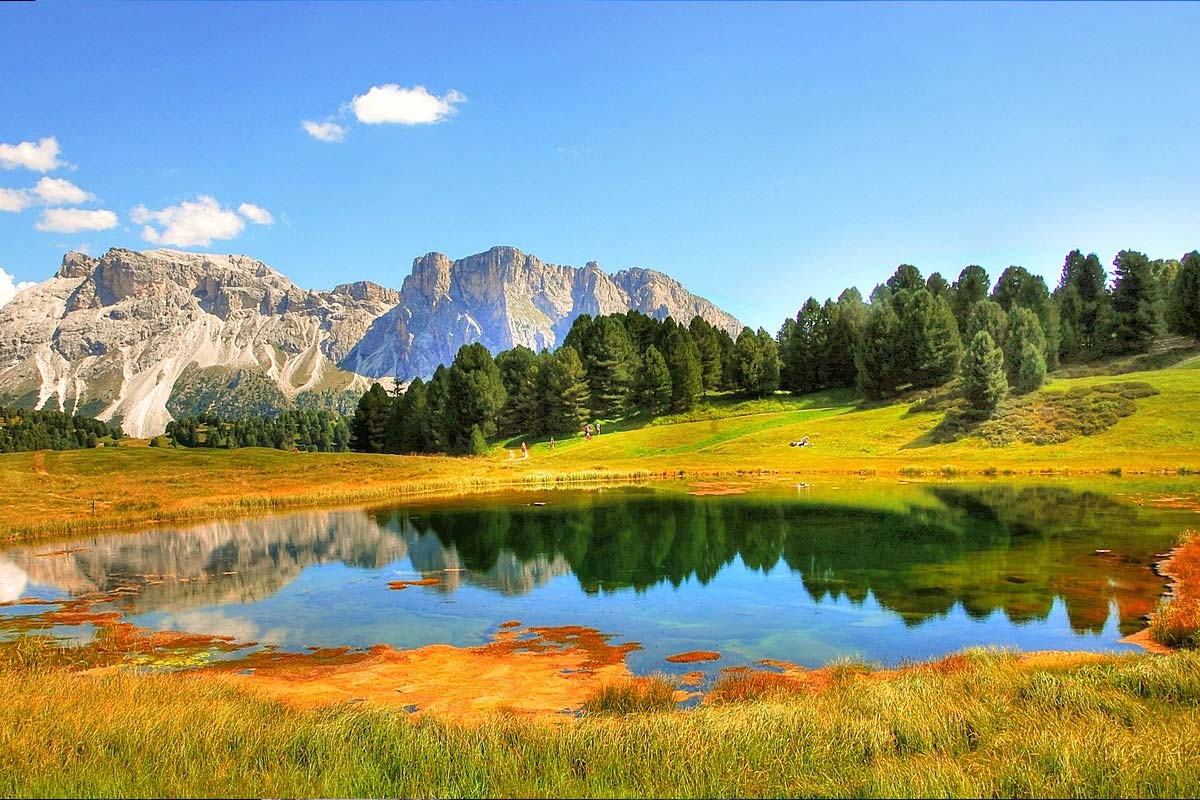
3. Dolomites, Trentino-Alto Adige/Veneto
The most beautiful Alpine passes in the Dolomites
The Dolomites are a mountain range located mainly in the regions of Trentino-Alto Adige and Veneto, in north-eastern Italy. This mountainous region is renowned for its natural beauty, breathtaking landscapes, towering peaks and rich cultural history. Here is some information and main attractions of the Dolomites:
Ski resorts: The Dolomites are one of Europe's leading ski destinations, with numerous renowned ski resorts such as Cortina d'Ampezzo, Madonna di Campiglio, Selva di Val Gardena and Arabba. These resorts offer an extensive network of ski slopes, modern ski lifts and spectacular views.
Hiking trails: The Dolomites are crossed by a vast network of hiking trails, which offer trekking opportunities of all levels of difficulty. From scenic family-friendly trails to more challenging mountaineering routes, there is something for all tastes and abilities.
Mountaineering and climbing: The Dolomites are a paradise for mountaineers and climbers, with numerous mountaineering routes, vertical walls and via ferratas. Iconic attractions such as the Tre Cime di Lavaredo, the Marmolada and the Sassolungo are popular destinations for mountain climbers.
Natural and cultural heritage: The Dolomites were declared a UNESCO World Heritage Site in 2009 for their extraordinary natural beauty and geological value. The region is also rich in history and culture, with numerous Alpine villages, historic churches, fortresses and museums that tell the story of local history and traditions.
Road cycling and mountain biking: The scenic roads and cycle paths of the Dolomites offer endless opportunities for road cycling and mountain biking enthusiasts. The famous Dolomite Marathon is one of the largest amateur cycling races in the world, attracting thousands of participants every year.
Spa resorts: The Dolomites are also famous for their spa resorts and wellness centres, where you can relax and regenerate after a day of outdoor activities. Spa towns such as Merano, Bormio and San Martino di Castrozza offer a variety of spa services and wellness treatments.
The Dolomites offer a wide range of activities and attractions for visitors throughout the year, making them an ideal destination for lovers of nature, outdoor sports and culture.
Where to sleep
In the Dolomites, both in Trentino-Alto Adige and in Veneto, there are many accommodation options ranging from larger cities to small mountain villages. These are some of the strategic locations and accommodation options you might consider:
Main cities and tourist centres: Places such as Bolzano, Trento, Cortina d'Ampezzo, Ortisei, Canazei and Corvara offer a wide range of hotels, bed & breakfasts, apartments and refuges. These places are great starting points for exploring the Dolomites and offer easy access to hiking trails, ski slopes and other attractions.
Mountain villages: There are numerous mountain villages in the Dolomites that offer an authentic and peaceful atmosphere. Some examples include Selva di Val Gardena, San Martino di Castrozza, Arabba and Madonna di Campiglio. Here it is possible to find alpine refuges, farmhouses and charming hotels immersed in nature.
Agritourisms: The Dolomites area is famous for its agritourisms, where you can stay in traditional farms and enjoy local cuisine and fresh products. These accommodations often offer a scenic location and an authentic experience of mountain living.
As for Lake Idro, it is located in the Lombardy region, south-west of Trentino-Alto Adige and Veneto. The strategic location depends on the travel itinerary and planned activities.
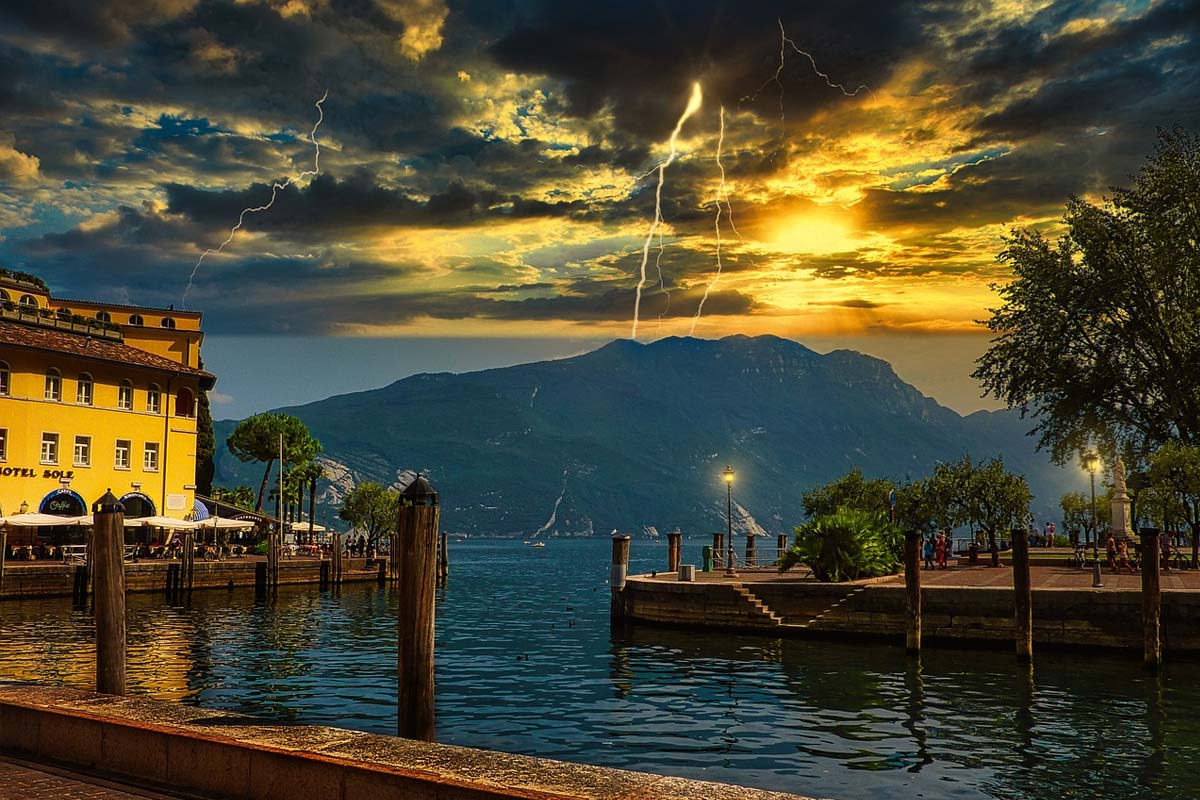
4. Lake Garda Loop, Lombardy/Veneto/Trentino-Alto Adige
The Lake Garda Ring is a fascinating cycling itinerary that entirely surrounds Lake Garda, the largest lake in Italy. Along the way, you can admire breathtaking views, discover picturesque towns and charming villages, and immerse yourself in the culture and gastronomy of the region. Here is some useful information on the Lake Garda Ring and suggestions on where to sleep along the route:
Route: The Ring of Lake Garda is approximately 160 kilometers long and crosses three regions: Lombardy, Veneto and Trentino-Alto Adige. The route mainly follows the lake shore, passing through cities and towns such as Desenzano del Garda, Sirmione, Salò, Gardone Riviera, Limone sul Garda, Riva del Garda, Malcesine and Peschiera del Garda.
What is the length and difference in altitude of the Lake Garda Loop?
The length and difference in height of the Lake Garda Ring depend on the specific route chosen and on the itinerary variations that can be made along the way. However, I can give you a general estimate based on the typical route taken by cyclists and motorists along the main roads surrounding the lake.
Length: The Ring of Lake Garda has an approximate length of approximately 160 kilometres. This measure includes the route that follows the lake shore through the surrounding cities and villages, touching the main population centers along the way.
Elevation difference: The total altitude difference of the Lake Garda Ring may vary depending on the starting and arrival points chosen along the route. However, in general, the route does not have very steep slopes or significant climbs, as it mainly follows the lake coast. This means that the total difference in altitude is relatively modest, with smaller variations in altitude than other mountain routes.
In summary, the Lake Garda Ring is a relatively flat and accessible cycling and driving route that circles the lake entirely, offering spectacular views and passing many of the towns and attractions along the lake's shores.
What are the most beautiful spots in the Lake Garda Loop?
Among the most beautiful places on the Ring of Lake Garda stand out Sirmione with its Scaligero Castle and thermal springs, Malcesine with its suggestive castle and the cable car to Monte Baldo, Limone sul Garda with its olive groves and enchanting beaches, Riva del Garda surrounded by the majestic Brenta Dolomites and its lively atmosphere, and Desenzano del Garda with its architectural beauty and leisure options. Each location offers breathtaking views, historic attractions and a wide range of activities, making the Lake Garda Loop an unforgettable experience.
Where to sleep
Desenzano del Garda and Peschiera del Garda (Lombardy): Desenzano del Garda and Peschiera del Garda are towns located on the southwestern side of the lake and offer a wide range of accommodation, including luxury hotels, bed & breakfasts, apartments and campsites. Both cities are excellent starting points for exploring the lake ring.
Sirmione (Lombardy): Sirmione is a picturesque town located on the southern tip of the lake, famous for its thermal springs and the Scaliger Castle. Here you can find charming hotels and spa facilities for a relaxing stay.
Riva del Garda (Trentino-Alto Adige): Riva del Garda is a pretty town located on the northern side of the lake, at the foot of the majestic Brenta Dolomites. It offers a range of accommodation, including hotels, bed & breakfasts and campsites, and is a great base for exploring the northern part of the lake.
Malcesine (Veneto): Malcesine is a picturesque town located on the eastern side of the lake, famous for its medieval castle and for being one of the best locations for windsurfing. Here you can find charming hotels and accommodation with lake views.
Strategic location of Lake Idro: Lake Idro is located a short distance south-west of Lake Garda, in the province of Brescia, in Lombardy. If you want to visit both lakes on your trip, you can choose a starting and ending point that includes both lakes in your itinerary. For example, Desenzano del Garda or Peschiera del Garda could be excellent bases from which to explore both lakes, as they are located close to Lake Garda and have easy access to Lake Idro.
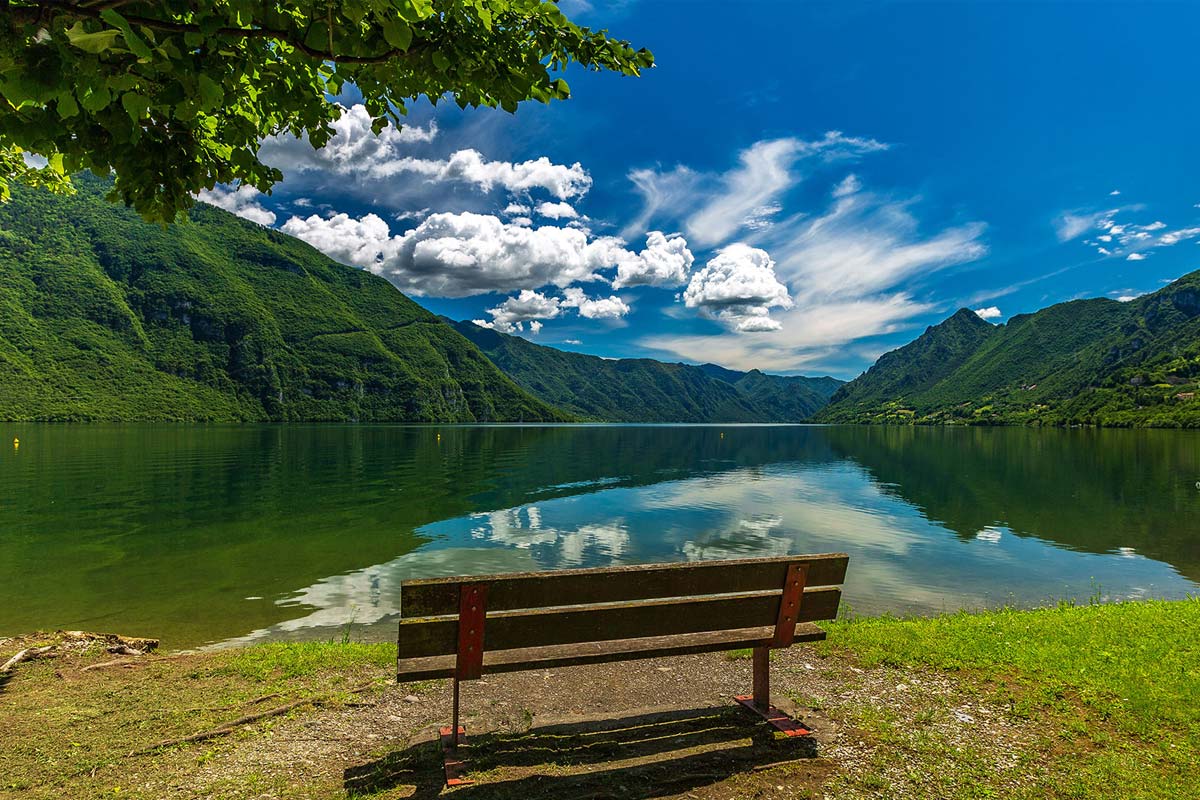
5. Lago d'Idro Loop, Lombardy
Try the new cycle path: from Lake d'Idro to the Brenta Dolomites
The new cycle path connecting Lake Idro to the Brenta Dolomites offers an extraordinary cycling experience through breathtaking landscapes and a variety of terrains. Along the route, cyclists can enjoy a combination of lake views, lush forests and majestic Dolomite mountains. Here is a hypothetical description of this fascinating cycle path:
Route: The cycle path begins on the picturesque shores of Lake Idro, where cyclists can immerse themselves in the tranquility of the crystal-clear waters and enjoy panoramic views of the surrounding mountains. From there, the route winds through charming mountain villages and wooded paths, leading cyclists through the valley to the imposing Brenta Dolomites.
Attractions along the route: Along the way, cyclists can stop to explore charming mountain villages, visit ancient castles and churches, and immerse themselves in the unspoiled nature of the natural parks along the route. Attractions such as the Stenico Castle, the village of San Lorenzo in Banale and the Adamello Brenta Natural Park are just some of the interesting stops along the route.
Difficulty and terrain: The cycle path offers a variety of terrain, with flat sections along the lake shores and challenging climbs as you approach the Brenta Dolomites. The route is suitable for cyclists of different skill levels, but requires good physical preparation to face the challenges of the climbs and descents along the route.
Where to sleep: Along the route, there are several accommodation options, including hotels, bed & breakfasts, mountain lodges and campsites. Cyclists can choose to stay overnight in picturesque mountain villages along the route or venture into the Brenta Dolomites for a wilder and more authentic experience.
In summary, the new cycle path connecting Lake Idro to the Brenta Dolomites offers an unforgettable cycling experience through some of the most spectacular landscapes in northern Italy. With its variety of terrains, interesting attractions and accommodation options, it is an unmissable adventure for cycling and nature lovers.
Where to sleep
Along the Ring of Lake Idro you can find various accommodation options, including hotels, bed & breakfasts, farmhouses and campsites, both in the small villages surrounding the lake and in larger towns such as Crone and Idro.
In summary, the Lake Idro Ring offers an authentic and relaxing experience immersed in nature and the beauty of the Lombard landscapes, making it an ideal destination for a peaceful and regenerating holiday.

